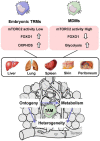Embryonic Origin and Subclonal Evolution of Tumor-Associated Macrophages Imply Preventive Care for Cancer
- PMID: 33919979
- PMCID: PMC8071014
- DOI: 10.3390/cells10040903
Embryonic Origin and Subclonal Evolution of Tumor-Associated Macrophages Imply Preventive Care for Cancer
Abstract
Macrophages are widely distributed in tissues and function in homeostasis. During cancer development, tumor-associated macrophages (TAMs) dominatingly support disease progression and resistance to therapy by promoting tumor proliferation, angiogenesis, metastasis, and immunosuppression, thereby making TAMs a target for tumor immunotherapy. Here, we started with evidence that TAMs are highly plastic and heterogeneous in phenotype and function in response to microenvironmental cues. We pointed out that efforts to tear off the heterogeneous "camouflage" in TAMs conduce to target de facto protumoral TAMs efficiently. In particular, several fate-mapping models suggest that most tissue-resident macrophages (TRMs) are generated from embryonic progenitors, and new paradigms uncover the ontogeny of TAMs. First, TAMs from embryonic modeling of TRMs and circulating monocytes have distinct transcriptional profiling and function, suggesting that the ontogeny of TAMs is responsible for the functional heterogeneity of TAMs, in addition to microenvironmental cues. Second, metabolic remodeling helps determine the mechanism of phenotypic and functional characteristics in TAMs, including metabolic bias from macrophages' ontogeny in macrophages' functional plasticity under physiological and pathological conditions. Both models aim at dissecting the ontogeny-related metabolic regulation in the phenotypic and functional heterogeneity in TAMs. We argue that gleaning from the single-cell transcriptomics on subclonal TAMs' origins may help understand the classification of TAMs' population in subclonal evolution and their distinct roles in tumor development. We envision that TAM-subclone-specific metabolic reprogramming may round-up with future cancer therapies.
Keywords: cancer target therapy; heterogeneity; metabolism; origins; subclonal evolution; therapy-resistant; tumor-associated macrophages (TAMs).
Conflict of interest statement
The authors declare that they have no competing interests.
Figures



Similar articles
-
From monocyte-derived macrophages to resident macrophages-how metabolism leads their way in cancer.Mol Oncol. 2024 Jul;18(7):1739-1758. doi: 10.1002/1878-0261.13618. Epub 2024 Feb 27. Mol Oncol. 2024. PMID: 38411356 Free PMC article. Review.
-
Nanomaterials-Involved Tumor-Associated Macrophages' Reprogramming for Antitumor Therapy.ACS Nano. 2024 Mar 19;18(11):7769-7795. doi: 10.1021/acsnano.3c12387. Epub 2024 Feb 29. ACS Nano. 2024. PMID: 38420949 Review.
-
Metabolic reprogramming in the immunosuppression of tumor-associated macrophages.Chin Med J (Engl). 2022 Oct 20;135(20):2405-2416. doi: 10.1097/CM9.0000000000002426. Chin Med J (Engl). 2022. PMID: 36385099 Free PMC article. Review.
-
Lipid Metabolic Regulatory Crosstalk Between Cancer Cells and Tumor-Associated Macrophages.DNA Cell Biol. 2023 Aug;42(8):445-455. doi: 10.1089/dna.2023.0071. Epub 2023 Aug 3. DNA Cell Biol. 2023. PMID: 37535386 Review.
-
Decoding the spatiotemporal heterogeneity of tumor-associated macrophages.Mol Cancer. 2024 Jul 27;23(1):150. doi: 10.1186/s12943-024-02064-1. Mol Cancer. 2024. PMID: 39068459 Free PMC article. Review.
Cited by
-
Irradiation Haematopoiesis Recovery Orchestrated by IL-12/IL-12Rβ1/TYK2/STAT3-Initiated Osteogenic Differentiation of Mouse Bone Marrow-Derived Mesenchymal Stem Cells.Front Cell Dev Biol. 2021 Sep 3;9:729293. doi: 10.3389/fcell.2021.729293. eCollection 2021. Front Cell Dev Biol. 2021. PMID: 34540843 Free PMC article.
-
Targeting of TAMs: can we be more clever than cancer cells?Cell Mol Immunol. 2024 Dec;21(12):1376-1409. doi: 10.1038/s41423-024-01232-z. Epub 2024 Nov 8. Cell Mol Immunol. 2024. PMID: 39516356 Free PMC article. Review.
-
Functionally and Metabolically Divergent Melanoma-Associated Macrophages Originate from Common Bone-Marrow Precursors.Cancers (Basel). 2023 Jun 24;15(13):3330. doi: 10.3390/cancers15133330. Cancers (Basel). 2023. PMID: 37444440 Free PMC article.
-
Tissue-Resident Macrophages in Cancer: Friend or Foe?Cancer Med. 2024 Nov;13(21):e70387. doi: 10.1002/cam4.70387. Cancer Med. 2024. PMID: 39494816 Free PMC article. Review.
-
Role of macrophages in tumor progression and therapy (Review).Int J Oncol. 2022 May;60(5):57. doi: 10.3892/ijo.2022.5347. Epub 2022 Apr 1. Int J Oncol. 2022. PMID: 35362544 Free PMC article. Review.
References
-
- Hashimoto D., Chow A., Noizat C., Teo P., Beasley M.B., Leboeuf M., Becker C.D., See P., Price J., Lucas D., et al. Tissue-resident macrophages self-maintain locally throughout adult life with minimal contribution from circulating monocytes. Immunity. 2013;38:792–804. doi: 10.1016/j.immuni.2013.04.004. - DOI - PMC - PubMed
-
- Bain C.C., Bravo-Blas A., Scott C.L., Perdiguero E.G., Geissmann F., Henri S., Malissen B., Osborne L.C., Artis D., Mowat A.M. Constant replenishment from circulating monocytes maintains the macrophage pool in the intestine of adult mice. Nat. Immunol. 2014;15:929–937. doi: 10.1038/ni.2967. - DOI - PMC - PubMed
-
- Tamoutounour S., Guilliams M., Sanchis F.M., Liu H., Terhorst D., Malosse C., Pollet E., Ardouin L., Luche H., Sanchez C., et al. Origins and Functional Specialization of Macrophages and of Conventional and Monocyte-Derived Dendritic Cells in Mouse Skin. Immunity. 2013;39:925–938. doi: 10.1016/j.immuni.2013.10.004. - DOI - PubMed
Publication types
MeSH terms
Substances
LinkOut - more resources
Full Text Sources
Other Literature Sources
Medical

